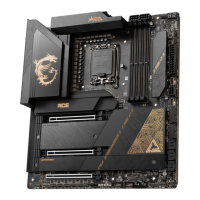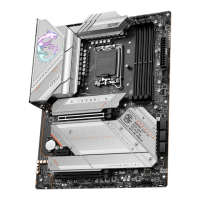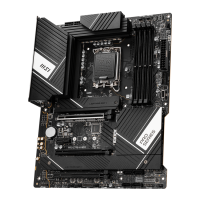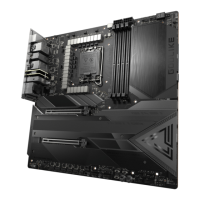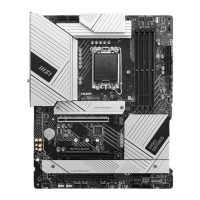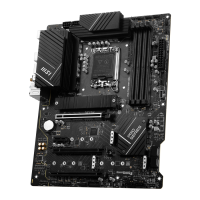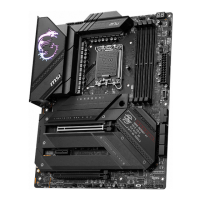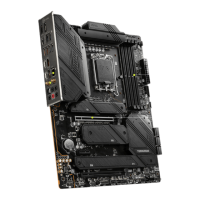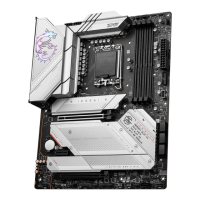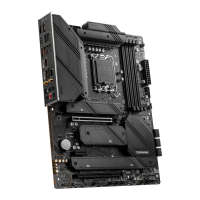Do you have a question about the MSI Z790-S01 and is the answer not in the manual?
Lists essential tools and components for computer assembly.
Provides crucial safety guidelines for handling components and assembly.
Information on supported CPUs, socket, and chipset.
Specifications for DDR5 memory and PCIe/M.2 expansion slots.
Information on M.2 slots, supported devices, and RAID configurations.
Highlights MSI Center capabilities and motherboard cooling solutions.
Provides instructions and important notes for installing the LGA1700 CPU.
Guides on installing memory modules for optimal performance.
Instructions for installing a Wi-Fi module into the M.2 slot.
Step-by-step instructions for installing M.2 SSDs into the slots.
Details on SATA connectors and important handling notes.
Information for connecting a Thunderbolt add-on card.
Instructions for connecting front panel audio jacks.
Guide for front panel audio, power, reset, LEDs, buzzer, and speaker connections.
Instructions for connecting the ATX power supply.
Configuring and resetting chassis intrusion warnings.
Information on connecting a Trusted Platform Module.
Details on fan connector types, modes, and power ratings.
Step-by-step guide to reset BIOS using the Clear CMOS jumper.
Instructions on how to replace the motherboard's CMOS battery.
Guides for connecting RGB LED strips and fans.
Step-by-step guide for installing Windows operating systems.
Information on using the MSI Center application for system optimization.
Advantages and compatibility considerations of UEFI BIOS.
Guide on how to verify the current BIOS mode.
Steps to access and configure BIOS settings.
Overview of function keys for BIOS navigation and actions.
Methods to restore BIOS to default settings.
Instructions for updating the BIOS using the M-FLASH utility.
Lists essential tools and components for computer assembly.
Provides crucial safety guidelines for handling components and assembly.
Information on supported CPUs, socket, and chipset.
Specifications for DDR5 memory and PCIe/M.2 expansion slots.
Information on M.2 slots, supported devices, and RAID configurations.
Highlights MSI Center capabilities and motherboard cooling solutions.
Provides instructions and important notes for installing the LGA1700 CPU.
Guides on installing memory modules for optimal performance.
Instructions for installing a Wi-Fi module into the M.2 slot.
Step-by-step instructions for installing M.2 SSDs into the slots.
Details on SATA connectors and important handling notes.
Information for connecting a Thunderbolt add-on card.
Instructions for connecting front panel audio jacks.
Guide for front panel audio, power, reset, LEDs, buzzer, and speaker connections.
Instructions for connecting the ATX power supply.
Configuring and resetting chassis intrusion warnings.
Information on connecting a Trusted Platform Module.
Details on fan connector types, modes, and power ratings.
Step-by-step guide to reset BIOS using the Clear CMOS jumper.
Instructions on how to replace the motherboard's CMOS battery.
Guides for connecting RGB LED strips and fans.
Step-by-step guide for installing Windows operating systems.
Information on using the MSI Center application for system optimization.
Advantages and compatibility considerations of UEFI BIOS.
Guide on how to verify the current BIOS mode.
Steps to access and configure BIOS settings.
Overview of function keys for BIOS navigation and actions.
Methods to restore BIOS to default settings.
Instructions for updating the BIOS using the M-FLASH utility.
| Socket | LGA 1700 |
|---|---|
| Chipset | Intel Z790 |
| Memory Type | DDR5 |
| Memory Slots | 4 |
| Max Memory Capacity | 128 GB |
| Memory Speed | DDR5-7200+ (OC) |
| M.2 Slots | 3 |
| SATA Ports | 4 |
| LAN | 2.5Gbps Ethernet |
| Audio | Realtek ALC897 |
| RAID Support | RAID 0, 1, 5, 10 |

